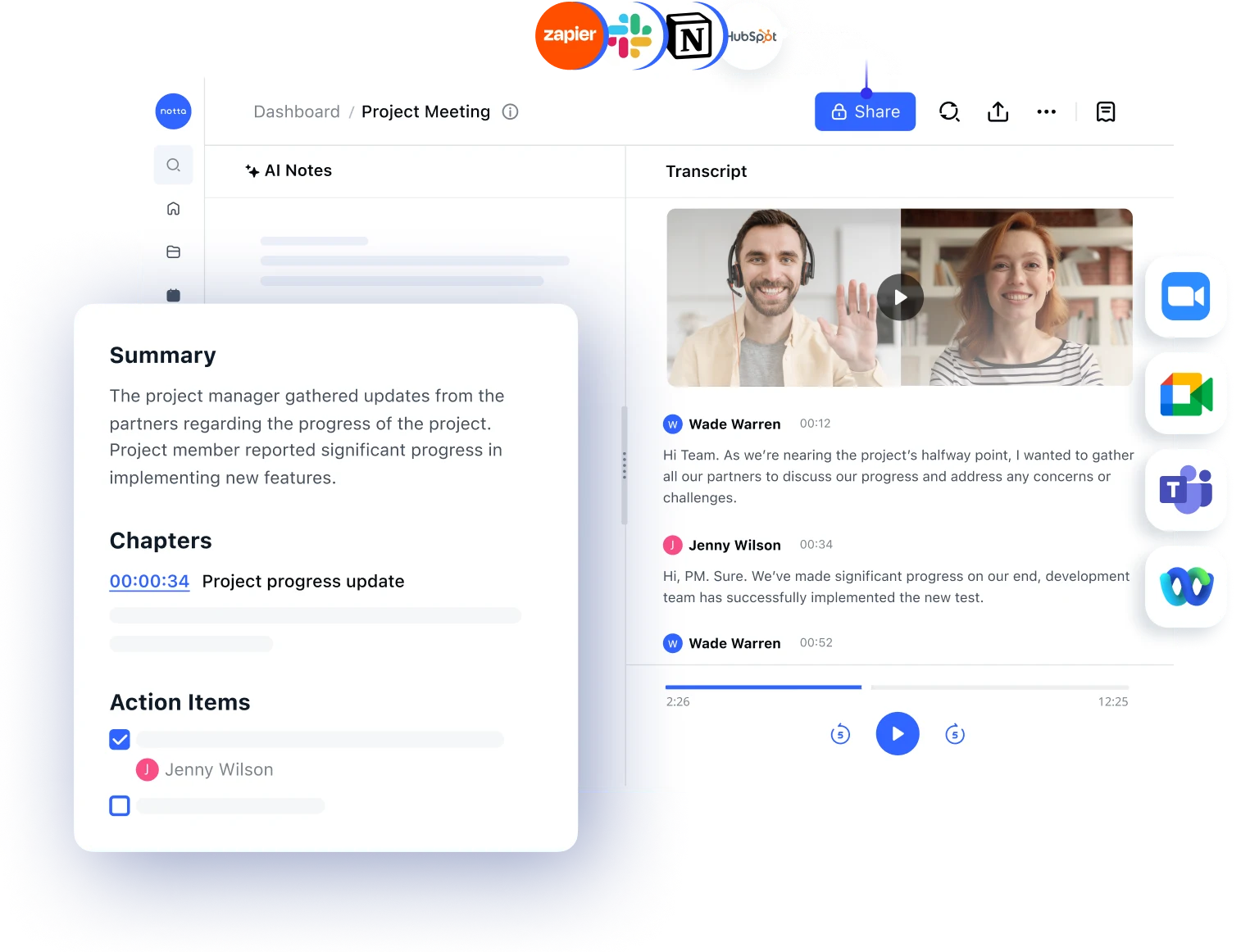
Top 10 Ground Rules for Effective Team Meetings
Unlock the power of AI — Notta's meeting assistant records, transcribes and summarizes meeting minutes with one click.
Let’s face it. We spend increasingly more time in meetings every year, especially if you have obtained a leader’s role. Although not funny, meetings constitute a large part of our working hours. What makes things worse is that many teams don’t set ground rules for meetings and therefore waste a lot of time.
Now it’s time to make a change.
If you are struggling to set ground rules for productive meetings, read on as we have listed 10 practices you can implement to improve overall team performance during a meeting.
Why are meeting ground rules important?
As an old saying goes, “Nothing can be accomplished without norms or standards.” This is also true with a meeting, whether online or offline.
Meeting ground rules are a set of standards that every attendee should follow to ensure the meeting goes smoothly and achieves productive results within a limited time.
It may not be easy to decide what ground rules to set for a meeting; just to make your task easier, our meeting scientists have brought 10 proven team meeting rules as a base.
Top 10 ground rules for successful meetings
1. Attend the meeting on time
Punctuality is the key to a perfect start.
The first rule is to set a time that favors all the attendees to ensure everyone is available for the meeting. It’s crucial that everyone shows up on time so that the meeting goes as expected. If you are the host of the meeting, joining the conferencing room a few minutes earlier is more advisable to make preparations.
Running late for a meeting not only disrupts the process but also wastes time. Do inform the host and other attendees if you have to be late.
2. Come prepared
Whatever the meeting type, coming prepared is always a good practice. Before the meeting starts, your team can read the meeting agenda (if any) to understand the aim of this meeting, collect related information, and prepare answers to potential questions that will be discussed.
When every team member comes prepared at a meeting, they will be confident enough to express their points and make exchanges.
3. Be present (physically and mentally)
Being mentally present at a meeting is just as important as being physically there.
We have all been in this situation: other meeting attendees are speaking, but we just let our minds wander, thinking about something else that is not related to the meeting. However, it is best to be present mentally as much as possible, which means listening actively, taking notes when necessary, and providing valuable insights.
4. Everyone participates
If you are the leader of the meeting, ensure that everyone in your team participates. To accomplish this, several group rules can be set, including:
Invite only the necessary people who can provide some input in a group meeting.
Make time for everyone to express their opinions and thoughts.
Don’t interrupt others while speaking.
Sometimes, people who aren’t active drag out the enthusiasm of others in meetings who are keen to contribute. So actively responding in the group meeting is as important as attending the conference.
5. Be open-minded
For any meeting to be productive, another vital ground rule for every meeting participant is to be open-minded and therefore create an inclusive environment.
Being open-minded means taking an active attitude towards different opinions because sometimes a unique insight can be approached by another person in the group. This may help you grasp some more points during the meeting and weigh your ideas better.
6. Tackle problems, not people
Always remember the purpose of your meeting is to solve a problem. Even if you disagree with someone, just express your opinions with adequate information instead of blaming the person.
Listen to everyone, jaw down their inputs, and if a problem arises, tackle that problem using constructive discussions.
7. Record notes and action terms
Apart from the meeting agenda, meeting notes and action terms are crucial during a meeting because they help you record each insight from various people who are contributing.
Hate to struggle with writing notes, especially when you need to actively participate? The Notta meeting assistant can be an excellent choice for you.
It will capture the conversations and generate a complete transcript as you speak. Afterward, you can review, edit, highlight action items, and share the meeting notes with all stakeholders to keep everyone informed, even if they don’t attend the meeting.

8. Discuss the undiscussable
Another important but often missed ground rule for team meetings is discussing the undiscussable issues. This ensures that the team concentrates on issues that sound unremarkable but can be advantageous once resolved.
To achieve this result, do not blame anyone for expressing their honest feelings because they could lead to an eventual discussion.
9. Stay on point and make decisions
Do not wander away from the subject and be afraid of making decisions.
Be aware of the agenda for the meeting. Concentrate on the main points and encourage the group to take a positive attitude throughout the conference. If this is a decision-making meeting, always finish the meeting with a final decision so that your team members know what to do next.
10. Don’t extend the meeting
Make sure that the deadline of the meeting is respected equally as the initiation.
People do not always prefer extended meetings. Set a time frame for the meeting, and end it soon. This will allow people to focus on providing only the critical points throughout the meeting as they will be well aware of concluding the meeting at a fixed time.
Notta offers the most integrated AI meeting notes, summaries, and action items so nothing gets missed.
How to implement ground rules for team meetings?
Above are the ready-to-use ground rules for effective meetings. You can also set your own list of ground rules depending on the company culture. Now it’s time to learn how to put them into action.
Discuss the meeting ground rules together with your team and craft a final version. Make sure your team explicitly agrees on the terms.
Inform both the meeting organizers and participants of the ground rules by email.
Gradually develop a team mindset that’s consistent with the ground rules.
If someone breaks the rules, look at its severity and take necessary action.
Set a quality standard for meetings
The proper meeting ground rules can assist you in conducting a professional meeting and ensure the most out of each session.
Rules don't constrain anyone, but they create space for professionalism. Follow the 10 ground rules as a start, and you can always improvise and then slowly implement them on a regular basis. Finally, do not forget that people observe keenly, so you have to be the one to follow these rules in the first place.